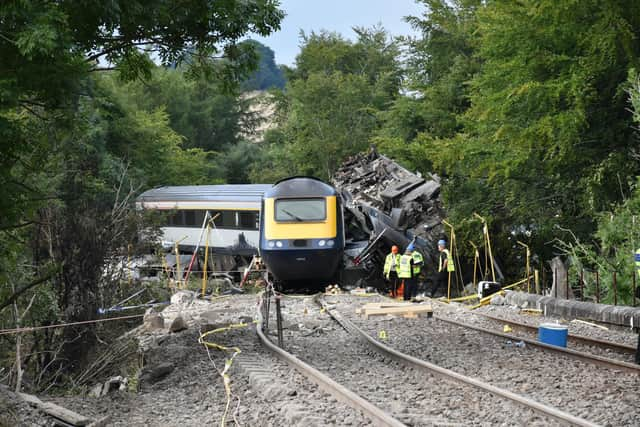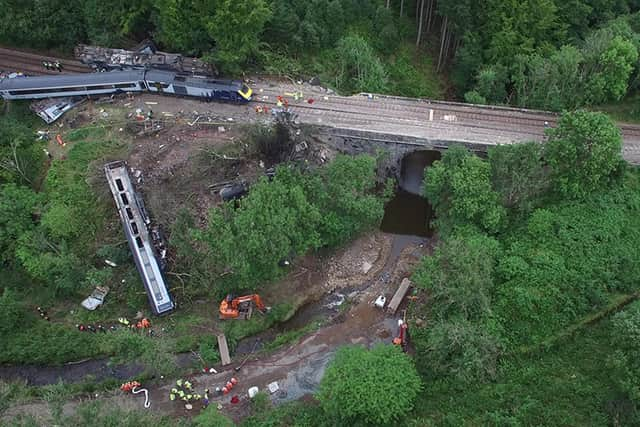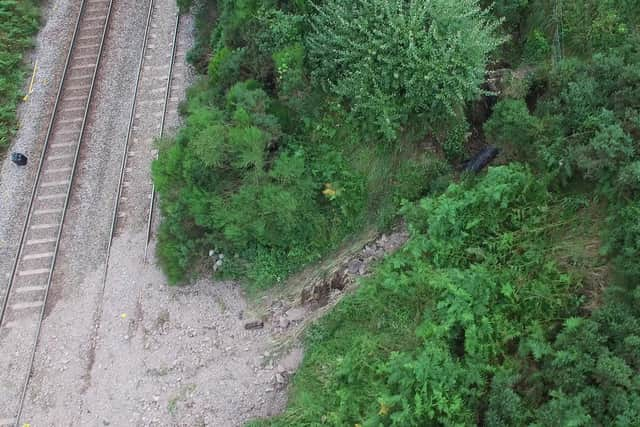Network Rail accused of 'negligence' as damning report reveals fatal Carmont train crash caused by wrongly-built drain
Lawyers for relatives of victims of the August 2020 crash said the final Rail Accident Investigation Branch (RAIB) report "clearly shows rail management had prior knowledge of several known risks – they were told to improve, yet still failed to act".
Three people – driver Brett McCullough, conductor Donald Dinnie and passenger Christopher Stuchbury – were killed and the other six people on the train were injured when it hit debris washed from the drain onto the track after intense rainfall.


Advertisement
Hide AdAdvertisement
Hide AdScotRail said pre-pandemic, the 6:38am Aberdeen-Glasgow service would have carried 25-30 passengers – up to six times as many – and the RAIB said “the casualty toll would almost certainly have been significantly higher”.
Train drivers union Aslef said failures highlighted in the report amounted to a “watershed moment for rail safety” and decried “endemic and tragic corporate failure“.
It called for the resignation of Scotland’s Railway managing director Alex Hynes, who oversees ScotRail and Network Rail Scotland, and the withdrawal of the 40-year-old train fleet involved by the third anniversary of the crash next year.
RAIB said it did not regard the Inter7City “High Speed Trains” as “unsafe”, but “the outcome would have been better” if they had complied with modern crashworthiness standards.


However, among 20 safety recommendations, it called for modifications to older trains to improve protection for passengers and crew, and improvements to the way Network Rail handled extreme weather, as well as better management of lineside drainage.
A separate, joint investigation by Police Scotland, British Transport Police and the Office of Rail and Road is continuing, whose report will be submitted to the Crown Office.
The RAIB said nearly a month’s rain fell in three hours before the crash, “but the drainage system and associated earthworks had not been constructed in accordance with the original design and so were not able to safely accommodate the water flows".
A bund, or earth bank, had been added, which funnelled water towards the drain, which became inundated and washed gravel onto the line.


Advertisement
Hide AdAdvertisement
Hide AdThe RAIB said if the drain had been built as designed, “it would have been capable of safely accommodating the flow of surface water that occurred on the morning of August 12, 2020 without causing gravel to be washed away down the steeply sloping trench towards the track”.
The drain was built by Carillion in 2011-12, which went into liquidation six years later.
The firm failed to inform Network Rail it was adding the bund to the system.
Investigators also found no evidence that Network Rail carried out any inspection of the upper parts of the drainage system between when it viewed the completed work in 2013 and the crash.
They said the UK Government-owned company failed to add that section to an internal programme that would have triggered routine inspections and maintenance.
RAIB chief inspector of rail accidents Simon French said he hoped the episode “will resonate throughout the UK’s construction industry”.
He said: “It is so sad that a project that was designed for the protection of the travelling public became unsuitable for its intended use and posed a hazard to trains because of such uncontrolled changes to the design.”
The investigation also found the driver had not been instructed to drive at lower speed despite other flooding and landslips in the area – a policy that has since changed.
Advertisement
Hide AdAdvertisement
Hide AdThe train, which had been ordered to return to Stonehaven after being halted by a landslip, was running at 73mph – near the speed limit for that section of line – when it derailed and then hit a bridge parapet, which caused the carriages to “scatter”.
Mr French said the railways must get “even smarter” about the way they countered the threat of extreme weather and better exploit technology that predicted and tracked storms.
He also called for more research on how trains could be kept in line rather than jack-knifing in crashes, and “to think about the longer-term implications of continuing to operate rolling stock that pre-dates modern standards”.
Neil Davidson, partner at Digby Brown Solicitors, which represents several of the victims' families, said: “This is a damning report which highlights a catalogue of failures within Network Rail.
“The investigation clearly shows rail management had prior knowledge of several known risks – they were told to improve, yet still failed to act.
“This is the very definition of negligence.”
Kevin Lindsay, Scottish organiser of drivers union Aslef, called for a public inquiry.
He said: “The failures identified in this report are so bad that we believe this must be a watershed moment for rail safety across the UK.
“Never again should our drivers be on trains where crashworthiness is not fit for purpose."
Advertisement
Hide AdAdvertisement
Hide AdMr Lindsay said Alex Hynes’ position was “untenable, and he must resign with immediate effect”.
The Rail, Maritime and Transport union called for an urgent safety summit.
General secretary Mick Lynch said: “There were systemic and structural failures in railway safety caused by fragmentation with different companies responsible for the management and implementation of safety critical work, signalling, operations and rolling stock.”
Network Rail chief executive Andrew Haines said the report showed there were “fundamental” lessons to be learned, but “it should not have taken this tragic accident” to highlight them.
He said: “We must do better and we are utterly committed to that", and expressed “our deep sorrow and regret” at the three deaths.
Mr Haines said similar locations had been inspected and two independent taskforces were investigating extreme rainfall events and better drainage management.
ScotRail chief operating officer Ian McConnell said: “This report makes for very sober reading.
“ScotRail will play its part fully in ensuring safety lessons are learned.
Advertisement
Hide AdAdvertisement
Hide Ad“Our thoughts and prayers remain with the families, friends, and colleagues of Brett, Donald and Christopher.”
A message from the Editor:
Thank you for reading this article. We're more reliant on your support than ever as the shift in consumer habits brought about by coronavirus impacts our advertisers.
If you haven't already, please consider supporting our trusted, fact-checked journalism by taking out a digital subscription.
Comments
Want to join the conversation? Please or to comment on this article.
